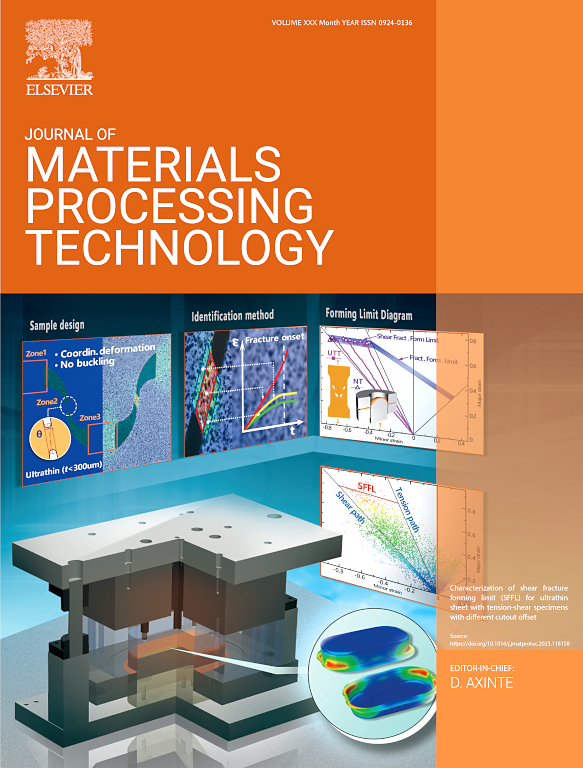高强析出硬化合金多道次冷焊组织演变及结合机制
IF 6.7
2区 材料科学
Q1 ENGINEERING, INDUSTRIAL
Journal of Materials Processing Technology
Pub Date : 2025-05-22
DOI:10.1016/j.jmatprotec.2025.118905
引用次数: 0
摘要
在不降低其性能的情况下加入高强度沉淀硬化合金是一项重大挑战。本研究以高强度(接近600 MPa) Cu-Cr-Zr合金为模型系统,对多道次对接冷焊作为无热连接方案进行了研究,探讨了潜在的组织演变和结合机制,旨在提供具有普遍价值的见解。经过三道或更多次焊接后,获得了高度完整的接头,表现出优异的抗拉强度(平均573 MPa,约为母材的96% %),同时保持了高导电性(约为国际退火铜标准的80%,%IACS)。系统分析表明,焊接过程中剧烈的局部塑性变形导致了显著的显微组织变化:最初的约10 μm纤维晶粒在接头中心细化为纳米(亚微米)等轴晶粒。至关重要的是,即使在室温下,这种严重变形也会导致强化Cr析出物的部分机械化学溶解,这突出了严重塑性变形(SPD)下相稳定性的一个关键方面。研究表明,纳米晶化的大量强化有效地补偿了析出相溶解造成的软化,提高了接头效率。结合机制是动态的,通过表面膜破裂开始,随后是广泛的塑性流动,排出污染物,并在多个通道中巩固界面。这些发现为在冷焊条件下析出硬化合金的极端应变、晶粒细化和相稳定性之间的相互作用提供了基本的见解,突出了该工艺在连接热效应有害的高级材料方面的潜力。本文章由计算机程序翻译,如有差异,请以英文原文为准。
Microstructural evolution and bonding mechanisms during multi-pass cold welding of high-strength precipitation-hardened alloys
Joining high-strength precipitation-hardened alloys without degrading their properties poses a significant challenge. This study investigates multi-pass butt cold welding as a heat-free joining solution, using a high-strength (nearly 600 MPa) Cu-Cr-Zr alloy as a model system to explore the underlying microstructural evolution and bonding mechanisms, aiming to provide insights of generic value. High-integrity joints were achieved after three or more welding passes, exhibiting exceptional tensile strength (average 573 MPa, about 96 % of base material) while retaining high electrical conductivity (about 80 percent International Annealed Copper Standard, %IACS). Systematic analysis reveals that severe localized plastic deformation during welding drives significant microstructural changes: the initial about 10 μm fibrous grains refine into nanocrystalline (sub-micron) equiaxed grains at the joint center. Crucially, this severe deformation also induces partial mechano-chemical dissolution of the strengthening Cr precipitates even at room temperature, highlighting a key aspect of phase stability under severe plastic deformation (SPD). The study demonstrates that the substantial strengthening from nanocrystallization effectively compensates for the softening caused by precipitate dissolution, enabling high joint efficiency. The bonding mechanism is shown to be dynamic, initiating via surface film rupture, followed by extensive plastic flow that expels contaminants and consolidates the interface over multiple passes. These findings provide fundamental insights into the interplay between extreme strain, grain refinement, and phase stability in precipitation-hardened alloys under cold welding conditions, highlighting the process's potential for joining advanced materials where thermal effects are detrimental.
求助全文
通过发布文献求助,成功后即可免费获取论文全文。
去求助
来源期刊

Journal of Materials Processing Technology
工程技术-材料科学:综合
CiteScore
12.60
自引率
4.80%
发文量
403
审稿时长
29 days
期刊介绍:
The Journal of Materials Processing Technology covers the processing techniques used in manufacturing components from metals and other materials. The journal aims to publish full research papers of original, significant and rigorous work and so to contribute to increased production efficiency and improved component performance.
Areas of interest to the journal include:
• Casting, forming and machining
• Additive processing and joining technologies
• The evolution of material properties under the specific conditions met in manufacturing processes
• Surface engineering when it relates specifically to a manufacturing process
• Design and behavior of equipment and tools.
 求助内容:
求助内容: 应助结果提醒方式:
应助结果提醒方式:


